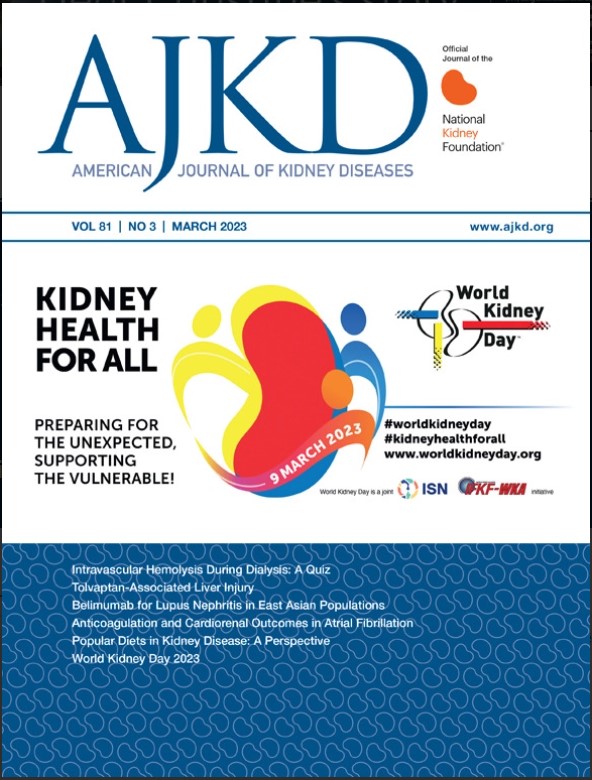尼马特利韦-利托那韦治疗晚期肾功能不全合并COVID-19患者的安全性和有效性。
IF 9.4
1区 医学
Q1 UROLOGY & NEPHROLOGY
引用次数: 0
摘要
理由与目的:virmatrelvir -ritonavir可预防高危成人COVID-19住院,但安全性问题限制了其在晚期肾功能不全患者中的使用。本研究检查了其在晚期肾功能不全患者中未经核准使用的安全性和有效性。研究设计:回顾性匹配队列研究。环境和参与者:2022年1月至2023年1月期间在退伍军人健康管理局设施中护理的肾小球滤过率(eGFR)估计为15-30 mL/min/1.73m2和COVID-19的患者。暴露:用尼马特利韦-利托那韦治疗,不使用尼马特利韦-利托那韦或莫那匹韦治疗,或用莫那匹韦治疗。结果:心脏事件、中风、急性肾损伤、肝损伤、高血压、感染相关死亡、呼吸衰竭、肺炎、严重感染和COVID-19诊断后30-60天内住院的发生率。分析方法:逻辑回归用于倾向匹配,标准化平均差异用于评估协变量平衡,条件逻辑回归用于估计相对风险比,比较每个结果的暴露。结果4020例eGFR 15 ~ 30 mL/min/1.73m2合并新冠肺炎患者中,117例(2.9%)接受尼马特利韦-利托那韦治疗(平均年龄75.6 [SD 12.2]岁,eGFR 24.9 [SD 4.0] mL/min/1.73m2)。与未使用尼马特利韦-利托那韦或莫努匹拉韦治疗相比,尼马特利韦-利托那韦治疗与心血管事件(如心力衰竭(RR 1.0 [95% CI, 0.7-1.2])、肝损伤(RR 1.2 [95% CI, 0.7-1.7])或急性肾损伤(RR 1.0 [95% CI, 0.8-1.2])的不同风险没有明显相关性,但与急性呼吸衰竭(RR 0.5 [95% CI, 0.2-0.7])和肺炎(RR 0.6 [95% CI, 0.3-0.8])的风险较低相关。与莫努匹拉韦治疗相比,尼马特利韦-利托那韦治疗与心血管事件、急性呼吸衰竭或肺炎的不同风险没有明显的相关性,但与急性肾损伤的高风险相关。对eGFR 15-35 ml/min/1.73m2患者的敏感性分析也得出了类似的结果。局限性:回顾性分析,研究队列中主要为男性。结论:在晚期肾功能不全的情况下使用尼马特利韦-利托那韦与急性呼吸衰竭和肺炎的风险降低相关,与未使用尼马特利韦-利托那韦或莫努匹拉韦治疗相比,非呼吸系统不良结局无明显差异。本文章由计算机程序翻译,如有差异,请以英文原文为准。
Safety and Effectiveness of Nirmatrelvir-Ritonavir in Patients With Advanced Kidney Dysfunction and COVID-19.
RATIONALE & OBJECTIVE
Nirmatrelvir-ritonavir prevents COVID-19 hospitalization among high-risk adults, but safety concerns limit its use in advanced kidney dysfunction. This study examined safety and effectiveness outcomes from its off-label use in patients with advanced kidney dysfunction.
STUDY DESIGN
Retrospective matched cohort study.
SETTING & PARTICIPANTS
Patients with estimated glomerular filtration rate (eGFR) 15-30 mL/min/1.73m2 and COVID-19 between January 2022 and January 2023 cared for in Veterans Health Administration facilities.
EXPOSURES
Treatment with nirmatrelvir-ritonavir, no treatment with nirmatrelvir-ritonavir or molnupiravir, or treatment with molnupiravir.
OUTCOMES
Incidence of cardiac events, stroke, acute kidney injury, liver injury, hypertension, and infection-related death, respiratory failure, pneumonia, severe infection, and hospitalization within 30-60 days of diagnosis with COVID-19.
ANALYTICAL APPROACH
Logistic regression for propensity matching, standardized mean differences for assessment of covariate balance, and conditional logistic regression for estimation of relative risk ratios comparing exposures for each outcome.
RESULTS
Among 4,020 patients with eGFR 15-30 mL/min/1.73m2 and COVID-19, 117 (2.9%) were treated with nirmatrelvir-ritonavir (mean age 75.6 [SD 12.2] years and eGFR 24.9 [SD 4.0] mL/min/1.73m2). Compared with no treatment with either nirmatrelvir-ritonavir or molnupiravir, treatment with nirmatrelvir-ritonavir was not detectably associated with different risks of cardiovascular events (e.g., heart failure (RR 1.0 [95% CI, 0.7-1.2]), liver injury (RR 1.2 [95% CI, 0.7-1.7]), or acute kidney injury (RR 1.0 [95% CI, 0.8-1.2]), but was associated with a lower risk of acute respiratory failure (RR 0.5 [95% CI, 0.2-0.7]) and pneumonia (RR 0.6 [95% CI, 0.3-0.8]). Compared with treatment with molnupiravir, treatment with nirmatrelvir-ritonavir was not detectably associated with different risks of cardiovascular events, acute respiratory failure, or pneumonia, but was associated with a higher risk of acute kidney injury. Sensitivity analyses among patients with eGFR 15-35 ml/min/1.73m2 yielded similar findings.
LIMITATIONS
Retrospective analysis, predominantly men in the study cohort.
CONCLUSIONS
Nirmatrelvir-ritonavir use in the setting of advanced kidney dysfunction was associated with a reduced risk of acute respiratory failure and pneumonia, and no detectable differences in non-respiratory adverse outcomes compared with no treatment with either nirmatrelvir-ritonavir or molnupiravir.
求助全文
通过发布文献求助,成功后即可免费获取论文全文。
去求助
来源期刊

American Journal of Kidney Diseases
医学-泌尿学与肾脏学
CiteScore
20.40
自引率
2.30%
发文量
732
审稿时长
3-8 weeks
期刊介绍:
The American Journal of Kidney Diseases (AJKD), the National Kidney Foundation's official journal, is globally recognized for its leadership in clinical nephrology content. Monthly, AJKD publishes original investigations on kidney diseases, hypertension, dialysis therapies, and kidney transplantation. Rigorous peer-review, statistical scrutiny, and a structured format characterize the publication process. Each issue includes case reports unveiling new diseases and potential therapeutic strategies.
 求助内容:
求助内容: 应助结果提醒方式:
应助结果提醒方式:


